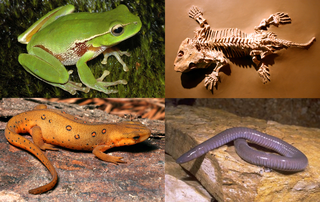
Amphibians are ectothermic, tetrapod vertebrates of the class Amphibia. All living amphibians belong to the group Lissamphibia. They inhabit a wide variety of habitats, with most species living within terrestrial, fossorial, arboreal or freshwater aquatic ecosystems. Thus amphibians typically start out as larvae living in water, but some species have developed behavioural adaptations to bypass this.
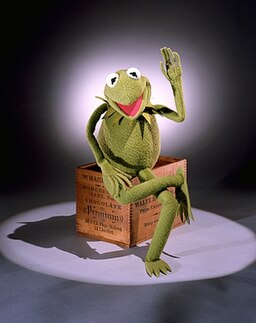
Kermit the Frog is a Muppet character created and originally performed by Jim Henson. Introduced in 1955, Kermit serves as the everyman protagonist of numerous Muppet productions, most notably Sesame Street and The Muppet Show, as well as in other television series, feature films, specials, and public service announcements through the years. He served as a mascot of The Jim Henson Company and appeared in various Henson projects.
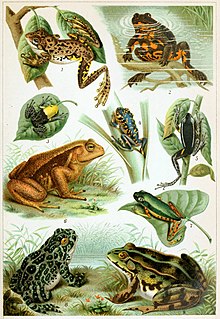
A frog is any member of a diverse and largely carnivorous group of short-bodied, tailless amphibians composing the order Anura. The oldest fossil "proto-frog" Triadobatrachus is known from the Early Triassic of Madagascar, but molecular clock dating suggests their split from other amphibians may extend further back to the Permian, 265 million years ago. Frogs are widely distributed, ranging from the tropics to subarctic regions, but the greatest concentration of species diversity is in tropical rainforest. Frogs account for around 88% of extant amphibian species. They are also one of the five most diverse vertebrate orders. Warty frog species tend to be called toads, but the distinction between frogs and toads is informal, not from taxonomy or evolutionary history.

Toad is a common name for certain frogs, especially of the family Bufonidae, that are characterized by dry, leathery skin, short legs, and large bumps covering the parotoid glands.

A tadpole is the larval stage in the biological life cycle of an amphibian. Most tadpoles are fully aquatic, though some species of amphibians have tadpoles that are terrestrial. Tadpoles have some fish-like features that may not be found in adult amphibians such as a lateral line, gills and swimming tails. As they undergo metamorphosis, they start to develop functional lungs for breathing air, and the diet of tadpoles changes drastically.

Frogger is a 1981 arcade action game developed by Konami and manufactured by Sega. In North America, it was released by Sega/Gremlin. The object of the game is to direct a series of frogs to their homes by crossing a busy road and a hazardous river.

LeapFrog Enterprises, Inc. is an educational entertainment and electronics company based in Emeryville, California. LeapFrog designs, develops, and markets technology-based learning products and related content for the education of children from infancy through grade school. The company was founded by Michael Wood and Robert Lally in 1994. John Barbour is the chief executive officer of LeapFrog.

Frog legs are one of the better-known delicacies of French cuisine, where it has been considered as a national delicacy.
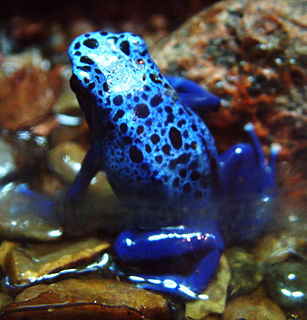
The Neobatrachia are a suborder of the Anura, the order of frogs and toads.

Poison dart frog is the common name of a group of frogs in the family Dendrobatidae which are native to tropical Central and South America. These species are diurnal and often have brightly colored bodies. This bright coloration is correlated with the toxicity of the species, making them aposematic. Some species of the family Dendrobatidae exhibit extremely bright coloration along with high toxicity, while others have cryptic coloration with minimal to no amount of observed toxicity. The species that have great toxicity derive this from their diet of ants, mites and termites. Other species however, that exhibit cryptic coloration and low to no amounts of toxicity, eat a much larger variety of prey. Many species of this family are threatened due to human infrastructure encroaching on their habitats.

The common frog or grass frog, also known as the European common frog, European common brown frog, European grass frog, European Holarctic true frog, European pond frog or European brown frog, is a semi-aquatic amphibian of the family Ranidae, found throughout much of Europe as far north as Scandinavia and as far east as the Urals, except for most of Iberia, Southern Italy, and the southern Balkans. The farthest west it can be found is Ireland. It is also found in Asia, and eastward to Japan. The nominative, and most common, subspecies Rana temporaria temporaria is a largely terrestrial frog native to Europe. It is distributed throughout northern Europe and can be found in Ireland, the Isle of Lewis and as far east as Japan.

Hylidae is a wide-ranging family of frogs commonly referred to as "tree frogs and their allies". However, the hylids include a diversity of frog species, many of which do not live in trees, but are terrestrial or semiaquatic.
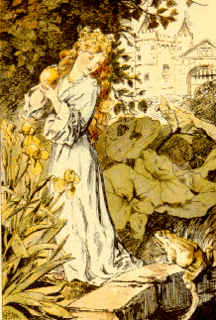
"The Frog Prince; or, Iron Henry" is a German fairy tale collected by the Brothers Grimm and published in 1812 in Grimm's Fairy Tales. Traditionally, it is the first story in their folktale collection. The tale is classified as Aarne-Thompson type 440.

The Australian green tree frog, also known as simply green tree frog in Australia, White's tree frog, or dumpy tree frog, is a species of tree frog native to Australia and New Guinea, with introduced populations in the United States and New Zealand, though the latter is believed to have died out. It is morphologically similar to some other members of its genus, particularly the magnificent tree frog (R. splendida) and the white-lipped tree frog (R. infrafrenata).

Crazy Frog is a Swedish CGI-animated character and Eurodance musician created in 2003 by actor and playwright Erik Wernquist. Marketed by the ringtone provider Jamba!, the character was originally created to accompany a sound effect produced by Daniel Malmedahl while attempting to imitate the sound of a two-stroke engine.
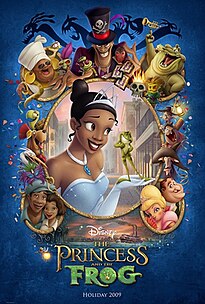
The Princess and the Frog is a 2009 American animated musical fantasy romantic comedy film produced by Walt Disney Animation Studios and released by Walt Disney Pictures. The 49th Disney animated feature film, it is loosely based on the 2002 novel The Frog Princess by E. D. Baker, which in turn is based on the German folk tale "The Frog Prince" as collected by the Brothers Grimm. The film was directed by John Musker and Ron Clements and produced by Peter Del Vecho, from a screenplay that Musker and Clements wrote with Rob Edwards. The directors also wrote the story with Greg Erb and Jason Oremland.

The TCU Horned Frogs football program is the intercollegiate football team of Texas Christian University (TCU). The Horned Frogs compete in Division I Football Bowl Subdivision (FBS), the highest level of intercollegiate athletics sanctioned by the National Collegiate Athletic Association (NCAA) in the United States.

Swikee or Swike is a Chinese Indonesian frog leg dish. The dish can be served as soup, deep fried or stir fried frog legs. Originally a Chinese dish, this dish is popular in Indonesia.

A tree frog is any species of frog that spends a major portion of its lifespan in trees, known as an arboreal state. Several lineages of frogs among the Neobatrachia have given rise to treefrogs, although they are not closely related to each other.

Pepe the Frog is an Internet meme consisting of a green anthropomorphic frog with a humanoid body. Pepe originated in a 2005 comic by Matt Furie called Boy's Club. It became an Internet meme when its popularity steadily grew across Myspace, Gaia Online and 4chan in 2008. By 2015, it had become one of the most popular memes used on 4chan and Tumblr. Different types of Pepe include "Sad Frog", "Smug Frog", "Angry Pepe", "Feels Frog", and "You will never..." Frog. Since 2014, 'rare Pepes' have been posted on the 'meme market' as if they were trading cards.



















